This blog post is a comprehensive guide to Customer Feedback, covering everything you need to understand about customer feedback, customer experience, text analysis and more. Let’s start by defining customer experience.
Customer Experience (CX)
What is Customer Experience?
Customer experience is the way a customer feels at all stages of doing business with a company or organization. Source
Customer Experience is about what customers feel (to the opposite of what they do) when using your company’s products or services. Customer Experience (shortened to CX) is essential when it comes to business results because right behind customers’ feelings are customers’ loyalty and wallet.
In an open/free market, the company having the best customer experience will always outpace competitors in the long run. This has proven to be true for many businesses over the years (Netflix vs Blockbuster, Apple vs Blackberry, Spotify vs Deezer, etc.).
So, customer experience is more than just what customers are doing when they interact with your organization and employees, but rather the company value that differentiates from competitors and computes in the long run.
Customer experience is not about saying yes to all customer feedback and being blindfolded into whatever your customers expect your team or business to be. It’s about listening better, identifying pain points in real time, and prioritizing the inputs that will set your company apart from competitors.
Customer Feedback is to Customer Experience What New Deals are to Sales
Customer feedback is the bloodstream that lets businesses measure how well they are doing regarding their customer’s expectations, the pain points that make them lag, and what their team needs to hear to do their best daily.
Yes, customer feedback isn’t just about reviews or negative survey responses, it’s about how you leverage this precious customer data for your company to win in the long run. Aligning customers’ needs, employees’ needs, and business results.
ROI of Customer Experience for your Team
The ROI (Return On Investment) of Customer Experience (including the process of managing your feedback data) is surprisingly fairly straightforward to measure. However, the main difficulty is to get operational metrics in your organization that you might not have on top of the shelf.
ROI of Customer Experience is basically:
- How much do I spend on CX? Tools and People.
- How much do I save with an optimized CX?
The first one is very easy to calculate on your side, summing up wages and invoices. The second one is based on two metrics: reduction of churn (how many customers did I not lose this month thanks to my investment in CX) and increase of revenue (increase of LTV (LifeTime Value) or new customers you reached thanks to features developed thanks to effective real-time customer feedback).
Different Types of Customer Feedback
There are 4 main customer feedback types in 2 dimensions
- How is it formatted?
- How is it collected?

Structured Customer Feedback
“Structured” feedback is customer feedback that follows a structure decided by your team and/or another organism. A simple example can be found in surveys. When you push a survey to your customers, you choose the structure of the feedback you will receive with metrics, questions, and a given order.
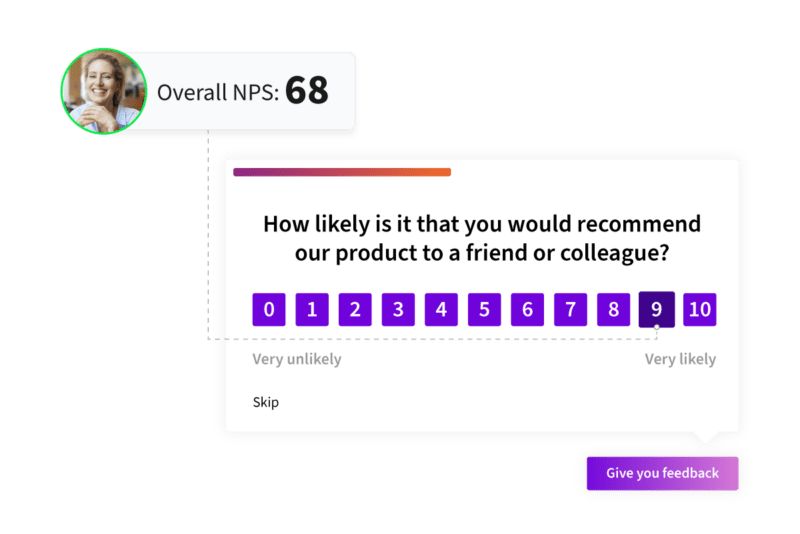
Here is a complete list of structured customer feedback :
- Net Promoter Score, CSAT, CES, and other customer satisfaction surveys
- Research surveys
- Online reviews such as Google Reviews or Trustpilot
Unstructured Customer Feedback
Opposite to structured customer feedback, unstructured ones come from open-ended questions or text. They are most of the time not related to specific metrics such as NPS, CSAT, or CES.
Here is a non-exhaustive list of unstructured customer feedback :
- Open-ended questions
- Bug reports
- Support chat or support ticket (coming from Jira for example)
- Documents
- CRM notes recorded by your sales team
- Customer interview transcript
- Social media comments
How to analyze unstructured customer feedback? Check out our article on Text Analysis.
Pushed Customer Feedback
Customer feedback is pushed, whenever your team sends a survey out by channels such as :
- A survey by email (for example when doing product development or customer support)
- A survey by SMS
- A survey by push widget
You are choosing deliberately at which touchpoint of the customer journey you’re measuring customer satisfaction. Your teal is proactive, not the client.
Pulled Customer Feedback
On the other side, pulled customer feedback is feedback your team did not collect or gather at a specific touchpoint by sending out a survey. These are :
- QR codes surveys
- Bug report surveys
- Support tickets
Collect Methods for Customer Feedback
There are different ways to gather customer feedback with different advantages and disadvantages based on the situation and your own context. Here is a quick summary of the main methods available today.
Import Existing Customer Feedback
There are two kinds of feedback import: manual or automated.
The first one, manual feedback import, is the process of taking feedback from one source (like a survey platform) , extracting it in a spreadsheet format, and importing it manually. The second one, automated import, is the process of using an API (such as Google Reviews API) to gather customer feedback regularly (at Feedier we do this on an hourly basis).
Advantages:
- Easy to set up.
- No extra cost.
- No need to disturb your customers as you are leveraging existing feedback data.
Limitations:
- If the import is based on historical data, your team might make decisions based on outdated customer feedback which might not be relevant.
Collect Customer Feedback by Email
This is by far the easiest way to collect customer feedback. Sending an email through any tool with a survey link call to action. It’s important to work and A/B test the content of the email, the CTA, and sending authentication.
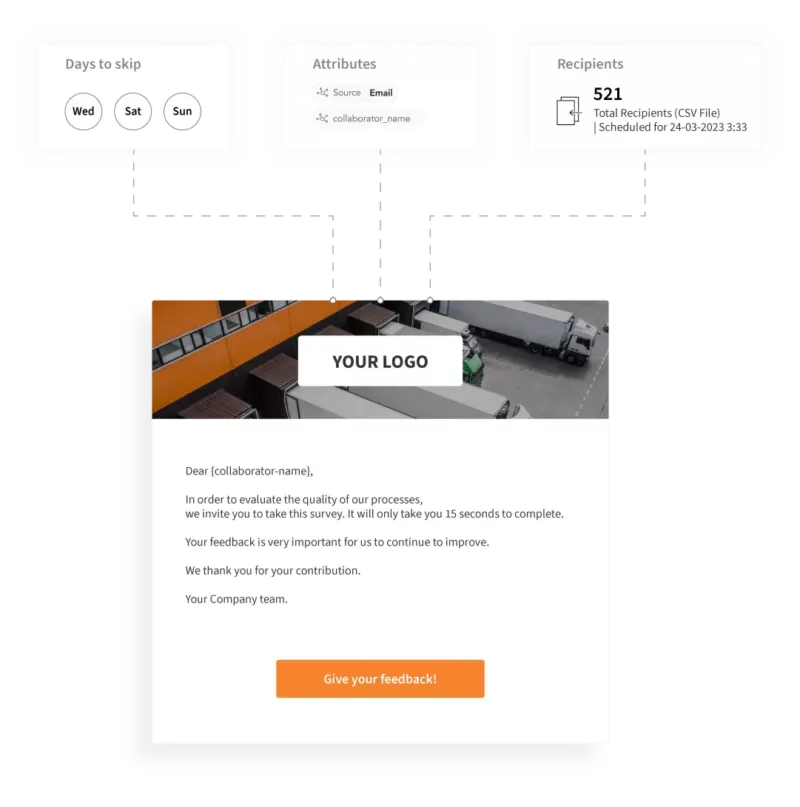
Advantages:
- Emails are pretty much free.
- Very easy to set up.
- Supports a wide range of question types
- Easy to connect with another system (as you have the customer email)
Limitations:
- Response rate can be very low based on your customer type. Response rates can vary anywhere from 5% to 30%. Some mechanisms such as DKIM or custom sender name (using your company domain) can help your team get a better response rate.
Collect Customer Feedback by SMS
Collecting feedback by SMS can be achieved by most VOC software (Voice of Customer tools) by either sending a SMS with a link to the survey or doing 2-way SMS surveys. Which is responding to the survey directly on the SMS app using follow-up SMS. While the latter might sound like a good idea, one should consider the price and limitation of support for different question types before going in this direction.
Advantages:
- The response rate is higher than emails.
Limitations:
- Cost. SMS are very expensive to send. Sending 10k SMS would cost ~ $700 in most countries outside the US.
Collect Customer Feedback by QR code
Post-COVID era, leveraging QR codes for customer feedback is excellent. It’s one of the only ways to gather feedback from non-digital touchpoints in your customer journey.
Advantages:
- Real-time feedback.
- Very convenient for the user.
Limitations:
- Could be expensive to set up (for example changing the packaging or printing hundreds of QR codes)
- It’s hard to enrich with other data. On other channels, it’s fairly straightforward to attach a customer ID or similar to connect the dots. With QR codes, your team can only personalize the link for every QR code and you don’t want to create 1 QR code by customer.
Collect Customer Feedback by Widget (web or in-app)
Leveraging your web or mobile applications to gather customer feedback is the most efficient way to listen to your customers. One common manner to trigger feedback widgets is to use a tag management system (Google Tag Manager or Tealium for example) to trigger a feedback widget based on the user/customer’s behavior.
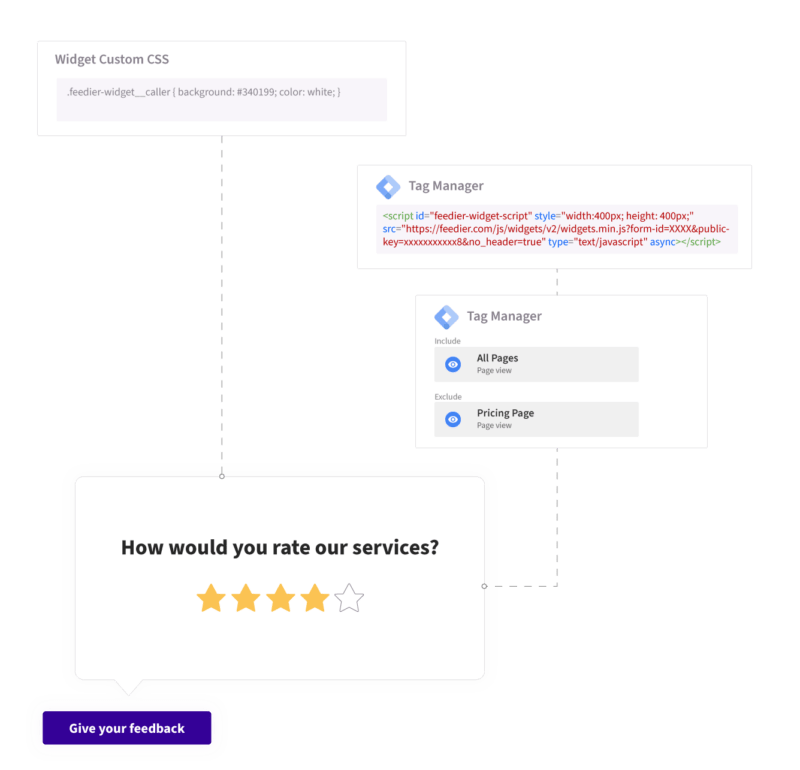
Advantages:
- Real-time feedback flow that can be collected at very precise touchpoints of the customer journey.
- Easy to enable/disable, as it’s fully digital.
- Easy to enrich with the session’s data (customer ID, history, etc.).
- No need to push/post messages in crowded mail inboxes.
- High response rate.
Limitations:
- Could be very time-consuming to set up if no tag manager (or similar system) is in place because it requires product time for scoping, developer time, testing time, etc.
Focus Groups
Focus groups involve a small group discussing specific topics, led by a facilitator, to provide qualitative feedback for business or research insights.
Advantages:
- Qualitative Data: They provide in-depth insights into participants’ attitudes, perceptions, and motivations, offering a deeper understanding than quantitative methods.
- Dynamic Interaction: The group setting encourages participants to react and build upon each other’s responses, leading to more spontaneous and varied feedback.
- Flexibility: They are adaptable to various topics and can be structured to explore complex issues, making them useful for a wide range of research objectives.
Limitations:
- Limited Representativeness: Due to their small size, focus group findings may not be statistically representative of the broader population.
- Group Dynamics Influence: Dominant participants can sway the group’s opinions, potentially skewing the results.
- Moderator Bias: The facilitator’s approach and biases can influence the discussion and the data collected, impacting the objectivity of the findings.
- Time Expensive: It takes a lot of time to recruit participants, arrange the focus groups and turn the meeting into actionable feedback.
Tools
Survey Management tools
The first basic way to manage all your customer feedback data is to use survey tools. Such tools may be Survicate, Google Forms, Microsoft Forms, or SurveyMonkey.
Advantages:
- They are cost-effective, and most of them are free.
- They are easy to start with. No sales call, just a signup button.
Limitations:
- Very limited reporting, so it takes a lot of time to analyze data and enable decision-making. Most of the work will happen on a spreadsheet.
- Not integrated with your team’s business tools, and workflows.
- Looks unprofessional for your customers and team members.
- No professional services such as consulting or data integrations.
Voice-of-Customer (VOC) tools
Voice of Customer (VOC) tools are methods or software applications used to gather, analyze, and respond to customer feedback.
The primary goal of VOC tools is to understand customers’ needs, expectations, preferences, and experiences with a product or service. Compared to survey tools, they take care of the analysis part and let your team close the loop.
Advantages:
- End-to-end tools that let you collect, analyze, and take action.
- Designed to collect real-time customer feedback.
- Reporting of KPIs such as NPS, CES, or CSAT are built-in and require limited efforts.
Limitations:
- Complex to use for operational teams without the right training. Most VOC tools contain an overwhelming data volume.
- The subjective nature of customer feedback can lead to bias if the feedback is not representative of the entire customer base.
- Expensive. VOC tools are resource-intensive, there are both technological and human costs.
- If used too much, customers may experience survey or feedback fatigue, especially if they are frequently asked for their input, leading to lower response rates and potentially less reliable data.
Despite these challenges, the benefits of VOC tools could outweigh the disadvantages, especially when businesses are strategic in their approach to collecting, analyzing, and acting on customer feedback.
Customer Intelligence Platforms (CIP)
A Customer Intelligence Platform (CIP) is a software used by businesses to centralize, analyze and interpret their customer data ( feedback, reviews, metadata, business data, etc.).
The aim of these platforms is to provide concrete, comprehensive insights into customer behavior, expectations and trends. This helps companies make data-driven decisions to improve the customer experience, optimize operational strategies, and drive business growth.
Key features and aspects of Customer Intelligence Platforms include:
- Data Integration: CIPs can integrate data from various sources such as transaction records, customer feedback, social media interactions, and web analytics. This integration creates a unified view of each customer.
- Customer Segmentation: They enable businesses to segment their customers into distinct groups based on behavior, demographics, purchase history, and other criteria. This segmentation aids in targeted marketing and personalized customer experiences.
- Predictive Analytics: Many CIPs use machine learning and other advanced analytical techniques to predict future customer behaviors, such as purchasing patterns, potential churn, and lifetime value.
- Real-Time Insights: These platforms often provide real-time analytics, allowing businesses to quickly respond to changing customer behaviors and market trends.
- Sentiment Analysis: They can analyze customer feedback and social media comments to gauge sentiment and identify areas of customer satisfaction or dissatisfaction.
Feedback Management Scores and Strategy
Principle 1: Start Small and Expand
The worst state is to not listen to your customers. It means, having no idea of why customers are leaving or spending more with your company. With this in mind, it’s better to do little than nothing. Keep in mind that the above examples are very interpretable based on your organization’s size.
What is a “small” feedback management program?
Starting small means capturing real-time feedback on one channel. Focusing on the touchpoint that is the easiest to capture in your customer journey. Usually, it means finding in the journey a digital touchpoint where you can have meaningful customer information.
For example:
- Post customer support interaction by using your Customer Support system and a simple chat survey.
- Post-order on an e-commerce website using your e-commerce system.
- Post-renewal for a SaaS business using the CRM to trigger the feedback survey.
At this stage, when listening on one channel with one system, actions will be limited and handled mostly by one team directly from the Feedback management owner.
What is a “fully expanded” feedback management program?
The final stage of customer feedback means 4 key milestones:
- Listening and capturing real-time feedback on all available channels in the customer journey (digital and non-digital). It means centralizing customer feedback so it can be analyzed similarly (whatever the source).
- Enriching feedback with other systems’ data to transform customer feedback into customer intelligence for your organization.
- Enrolling operational teams from multiple departments to manage customer feedback and take action daily. This can be achieved using specific dashboards, pre-trained AI models on your industry, and using a tool that is simple to use and not designed for data experts.
- Having a clear ROI of customer feedback action for your management: detractors and promoters.
Principle 2: Centralize all Customer Feedback in One Place
Customer feedback is horizontal data that belongs to many departments in the same organization (product, sales, customer support, management, etc.). An efficient feedback management strategy is to centralize all customer feedback in one place (our dedicated page on feedback centralization).
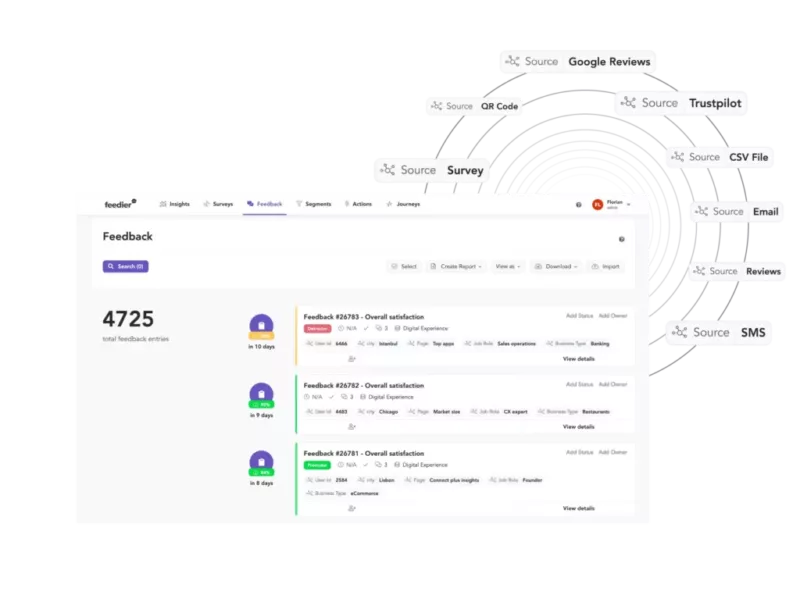
Key advantages of customer feedback centralization include:
- Breaking silos of information in your company
- Enabling data correlation by leveraging several sources of customer feedback
- Saving money on reducing survey costs in one place
- Dispatch the right report to the right team, instead of having a survey anarchy in your company
It’s important to note that feedback centralization works great for organizations (including subsidiaries of large enterprises) under 5,000 employees. After this group size, centralization could have a harmful impact of lowering the engagement of the operational employees or having processes that might not apply to all teams.
Principle 3: Use Existing Business/Operations Data to Get Better Customer Insights
Capitalizing on existing customer data such as CRM system, support system or operational system makes the customer feedback way more actionable. This process is called Feedback Enrichment.
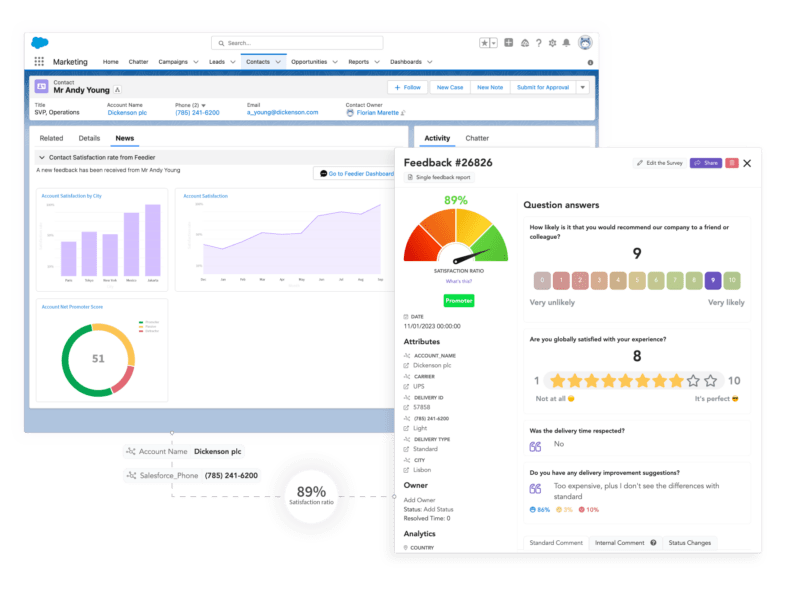
It gives levels of shades for every single indicator or customer feedback.
Example 1: A company having an NPS of 45, is not actionable. Enriching with the age group attribute from a CRM system would provide a more precise indicator:
- NPS (age < 18) = 12
- NPS (age 18-30) = 17
- NPS ….
- NPS (age 60+) = 80
In this example, focusing on younger customers will provide a much greater impact.
Example 2: A company receiving the review “Your product is not great”, is not actionable. Enriching with the lifetime value, customer history with the product, and customer email would let a support agent make the right decision on how to escalate the issue.
More details can be found in the “Leveraging customer feedback” section below.
Principle 4: Take Data Privacy & Security Seriously
Customer feedback by definition includes customer data. This customer data (in feedback data) is not always personal, however, it must be handled with great care to avoid regulation issues (GRPD, HIPAA, CCPA, etc.). Here is a list of recommendations to treat customer feedback in a secure and compliant way:
- Do not collect what’s not needed for the analysis. For example, if you are attaching customer feedback to its customer profile, the birth date (20/01/95) is less actionable and personal than the age group (20-30 years). It’s the same for customer attributes such as account ID, postal address, or signup date, it’s more secure and relevant to use attributes that will group the insight (state vs address, age group vs birthdate, etc.).
- Anonymise when possible. Thanks to Natural Language Processing (NLP) (read our dedicated page on NLP solution), it’s now possible for tools such as Feedier to anonymize personal names.
Example: “John D. was a real idiot and did not help me solve the problem for my account 1281818” can automatically be transformed into: “***** was a real idiot and did not help me solve the problem for my account ********”. - Work with software that is compliant with information security programs such as ISO 27001 or SOC II. The compliance programs force feedback management tools to have clear rules and processes when it comes to dealing with your customers’ data.
Principle 5: Giving Access to the Operations
To make customer feedback a success and a key part of your company’s transformation / strategic advantage, action must happen on the “ground”. It’s the people in contact with your customers that will make the difference.
Giving access to your Customer Feedback system (Voice of Customer or Customer Intelligence Platform) to the operational teams will have a massive impact on:
- Employee engagement. By having a real-time flow of customer feedback (sometimes negative feedback but also positive), employees can take ownership and find deep meaning in their daily work.
- Business growth. The ability to transform and growth is proportional, in any organization, to the people behind it. If you can improve processes/services/products from the bottom up, it will be more substantial and impactful.
Principle 6: Measure Return on Investment
Customer feedback is too often viewed as nice to have with no real business impact. Why would listening to customer feedback bring more sales and growth? Good question. That’s why it’s important to measure it.
The first good way to measure ROI (on top of advice in the “ROI of customer experience for your team”) is to enrich Feedback data with the customer lifetime value attached (likely coming from your CRM or operational system). This way, your team can evaluate the cost of detractors and the value of promoters in real time.
Leveraging Customer Feedback
Whether running a product team, customer support team, or sales team, leveraging customer feedback is key to driving better business results. Yet, it takes more work to leverage customer feedback into actionable insights.
The Importance of Data Correlation
Data correlation in customer feedback involves linking different types of data to gain a comprehensive understanding of the customer experience. By correlating feedback with other metrics such as purchase history, customer demographics, or service usage patterns, businesses can uncover hidden insights and understand the broader context of the feedback.
Correlation helps in identifying trends and patterns that might not be evident through isolated feedback. For instance, correlating customer satisfaction scores with specific product features can reveal what aspects are most valued by customers, or where improvements are needed.
Also, data correlation is key in predictive analytics. By understanding how different variables interact, businesses can predict future trends, customer behaviors, and potential pain points. This foresight enables proactive decision-making.
Last but not least, data correlation breaks down silos within an organization. It promotes a culture where different departments collaborate, sharing insights and working together towards a common goal of improved customer satisfaction.
The Impact of AI on Customer Feedback
When it comes to the AI revolution, the impact of customer feedback analysis is massive. The two main impacts are regarding the analysis and recommendations parts of the process:
- Analysis: Artificial Intelligence (AI), particularly NLP (Natural language processing), can analyse, interpret and understand human language in feedback. This means AI can analyze open-ended responses, detect sentiment, and extract meaningful insights from qualitative data, which was previously a manual and time-consuming task.
- Recommendations: AI excels in identifying patterns and trends in large datasets. By analyzing customer feedback, AI can uncover underlying issues, preferences, and opportunities that might not be immediately apparent. The next step is to leverage the Large Language Model (LLM) to make recommendations to the operations team in real-time.
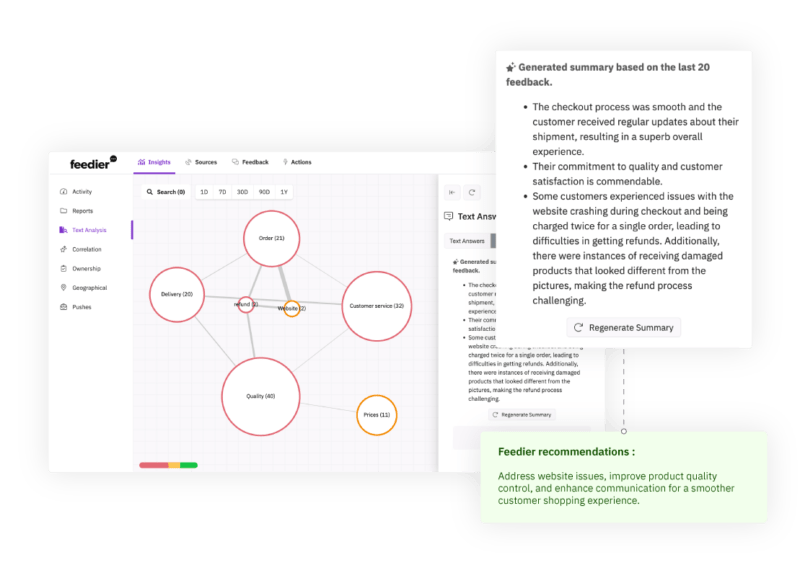
Customer Feedback vs Customer Intelligence
Customer Intelligence is a broader concept that encompasses the insights gained from analyzing customer feedback and other data sources (learn more about Customer Intelligence on our dedicated website page). It involves understanding customers’ behaviors, preferences and needs based on a wide range of data, including feedback, purchasing history, online behavior, and demographic information. It’s strategic, aiming to create a comprehensive view of the customer to inform business decisions. Customer feedback is a key component of Customer Intelligence. Without feedback, the intelligence is incomplete, as it lacks the direct voice of the customer. Customer intelligence often starts with customer feedback but goes beyond it by integrating and analyzing various data sources to gain a deeper, more actionable understanding of the customer.
Platforms like Feedier can help in both collecting customer feedback efficiently and integrating it with other data sources to build comprehensive Customer Intelligence.






